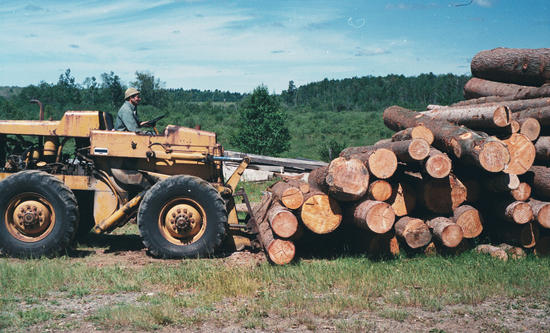 The property also came with an even more modern payloader from the 1950s.
The payloader had a forklift fork in place of a shovel, for
moving logs and piles of lumber.
The property also came with an even more modern payloader from the 1950s.
The payloader had a forklift fork in place of a shovel, for
moving logs and piles of lumber.
The sawmill had the fittings and such from an old steam powered sawmill that were not uncommon in the early 1900s. However, power was provided by something a little more modern: A 1938 McCormic Deering bulldozer style tractor which had a power takeoff flat belt pulley on the back.
 The property also came with an even more modern payloader from the 1950s.
The payloader had a forklift fork in place of a shovel, for
moving logs and piles of lumber.
The property also came with an even more modern payloader from the 1950s.
The payloader had a forklift fork in place of a shovel, for
moving logs and piles of lumber.
The payloader leaked oil when the hydraulic system was pressurized. My dad never fully filled the hydraulics on the belief that it might leak less when not full. Sometimes it ran out of oil when the cylinders were extended.
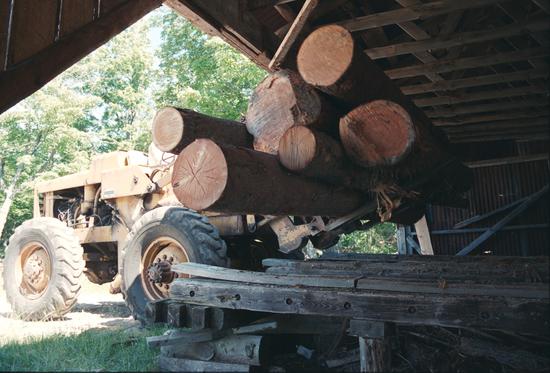 The loader's old flathead 6 cylinder gasoline engine was not terribly efficient,
and also caused its share of problems.
In later years the generator (a predecessor of the alternator)
no longer charged the battery, so we charged it with a battery charger
between uses. Nevertheless, the thing was very useful and worked
most of the time. Nothing like a payloader when you have to move some heavy stuff.
The loader's old flathead 6 cylinder gasoline engine was not terribly efficient,
and also caused its share of problems.
In later years the generator (a predecessor of the alternator)
no longer charged the battery, so we charged it with a battery charger
between uses. Nevertheless, the thing was very useful and worked
most of the time. Nothing like a payloader when you have to move some heavy stuff.
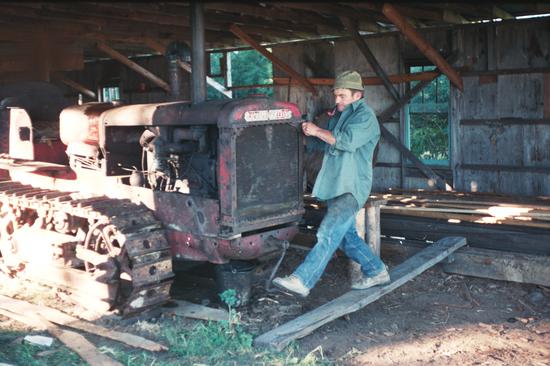 Even though the tractor predated the loader by about 20 years, its engine was more
advanced.
The tractor's engine was a 4 cylinder gas/diesel engine that was started by hand.
The 'gas' mode of operation of the engine was strictly used for starting, as
starting a cold diesel engine would not have been possible by hand.
Even though the tractor predated the loader by about 20 years, its engine was more
advanced.
The tractor's engine was a 4 cylinder gas/diesel engine that was started by hand.
The 'gas' mode of operation of the engine was strictly used for starting, as
starting a cold diesel engine would not have been possible by hand.
By hand is actually a bit of a misnomer, because the engine could only be turned by inserting the crank at the right angle, and then stepping on it and giving it a kick. Each kick turned the engine by half a turn. With a four stroke engine, the minimum number of strokes it should possibly take is three, and the record was getting it started in four kicks. Sometimes, on bad days, it took 40 kicks, which is 20 turns. Compared to a lot of cars, that's not too bad.
The engine usually took a few seconds to start running on all cylinders. As often as not, it stalled before it got up to speed. It was always tense when the engine, having just had one piston fire once, spun a few turns, and we hoped that somehow another piston would magically fire to keep it going.
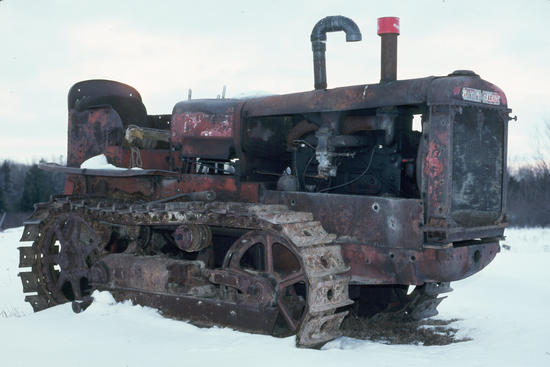 Once the engine was started in gas mode, it was let run for a few minutes.
After A certain time, a mechanism would release the switchover lever, and the
engine would make a tremendously loud clacking and thundering noise as it switched.
Starting on diesel, as far as I know, was done purely on momentum from 'gas mode'.
For some reason, it never stalled on switchover.
Getting it started was sufficiently difficult that we always left it idling during
lunch. Restarting it in gas mode while hot was next to impossible.
Once the engine was started in gas mode, it was let run for a few minutes.
After A certain time, a mechanism would release the switchover lever, and the
engine would make a tremendously loud clacking and thundering noise as it switched.
Starting on diesel, as far as I know, was done purely on momentum from 'gas mode'.
For some reason, it never stalled on switchover.
Getting it started was sufficiently difficult that we always left it idling during
lunch. Restarting it in gas mode while hot was next to impossible.
The engine was remarkably fuel efficient, despite only working on three cylinders. I later found an article about a certain tractor that that company built, and the engine was a great step forward in sophistication and fuel economy. It introduced some modern technologies such as brass sleeve bearings and overhead valves to engines of that size. It turns out that that engine was in that tractor.
Over the years, various things went wrong with the tractor. First the clutch, and custom parts had to be made. Then the injection pump started acting up periodically. When the governor stopped working, my dad gave up fiddling with it. It was exposed to the elements for a few years, but was later hauled away buy a guy who got it running again, though, as always, only on three cylinders.
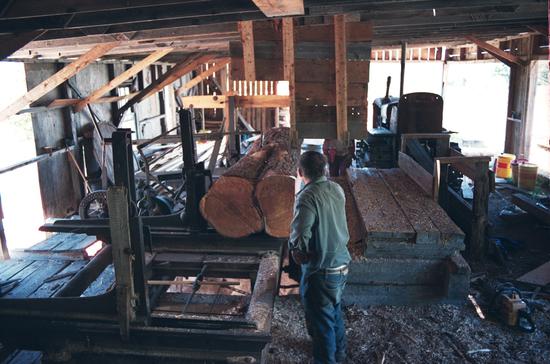 The carriage and tracks of this sawmill were much more solid than of the typical
hobby sawmill. The carriage to hold the logs had solid
cast iron parts, and axles of about 3" diameter steel. The main drive shaft on which
the saw blade was mounted was also about 3" in diameter.
The carriage and tracks of this sawmill were much more solid than of the typical
hobby sawmill. The carriage to hold the logs had solid
cast iron parts, and axles of about 3" diameter steel. The main drive shaft on which
the saw blade was mounted was also about 3" in diameter.
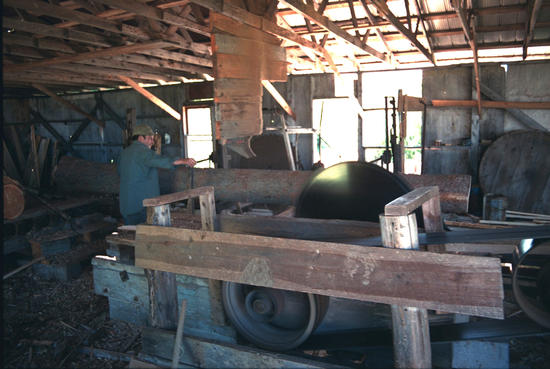 A clever system of flat belts and friction wheels in the casing between the drive
pulley and the saw blade allowed controlling the movement of the heavy
log carriage with a wooden lever.
The lever moved a tire back and forth, which would push against drums rotating in
either direction. The tire was coupled with a U-joint to a drum which had about five
turns of the steel cable wrapped around it, and was coupled to the carriage
via pulleys on both ends of the track. This mechanism worked remarkably well.
A clever system of flat belts and friction wheels in the casing between the drive
pulley and the saw blade allowed controlling the movement of the heavy
log carriage with a wooden lever.
The lever moved a tire back and forth, which would push against drums rotating in
either direction. The tire was coupled with a U-joint to a drum which had about five
turns of the steel cable wrapped around it, and was coupled to the carriage
via pulleys on both ends of the track. This mechanism worked remarkably well.
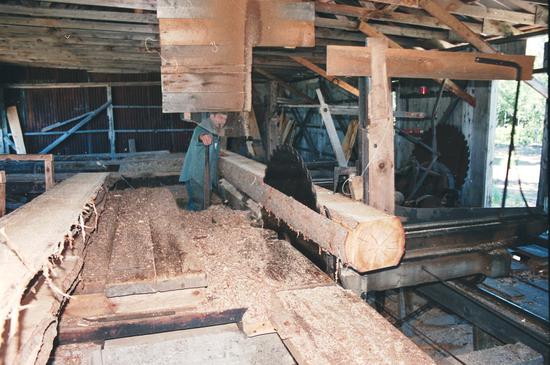 The first cut off any side of the log is called a 'slab'. This is essentially
waste. We cut those into firewood for heating the workshop.
The first cut off any side of the log is called a 'slab'. This is essentially
waste. We cut those into firewood for heating the workshop.
This sawmill had no powered means of rotating the logs on the carriage. Instead, a canthook had to be used to flip the log by 90 or 180 degrees. I always found it remarkable how (relatively) easily a log is manipulated with a good cantook, although during normal operation, I was always the one on the other side of the mill picking up the cut lumber.
Boards are cut from a log by running it past the blade and back. The log is moved closer to the blade in increments by pushing and pulling the lever attached to the ratchet on the carriage.
The blade would always get pulled into the log a bit on account of the angle at which it was mounted. However, it always pulled the same amount on each cut, so the net effect was not very noticeable on the boards cut.
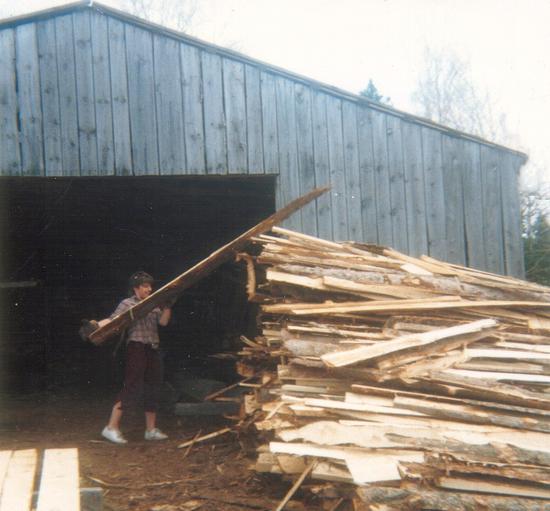 The slab pile. This pile would grow quite large. Periodically, my dad hauled it
away with the loader, dumping it near the workshop, where we'd cut the slabs
into short sections with a chainsaw to use as firewood in the workshop.
The slab pile. This pile would grow quite large. Periodically, my dad hauled it
away with the loader, dumping it near the workshop, where we'd cut the slabs
into short sections with a chainsaw to use as firewood in the workshop.
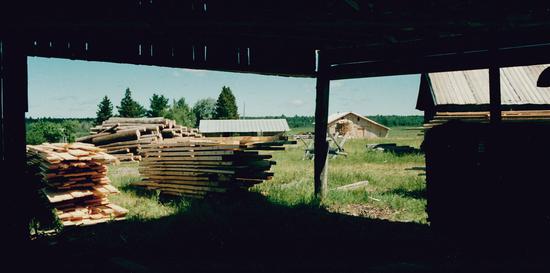 My job, when we ran the sawmill, was to take the boards from where the above picture
was taken, and sort them by thickness. My dad would always look at the quality
of lumber as it came out, and decided how thick to cut it for what job as he went
along. Operating the sawmill is a two man job minimum, and works better with three.
My sisters always hated it when they had to help in the
sawmill after my older brother went off to university.
My job, when we ran the sawmill, was to take the boards from where the above picture
was taken, and sort them by thickness. My dad would always look at the quality
of lumber as it came out, and decided how thick to cut it for what job as he went
along. Operating the sawmill is a two man job minimum, and works better with three.
My sisters always hated it when they had to help in the
sawmill after my older brother went off to university.
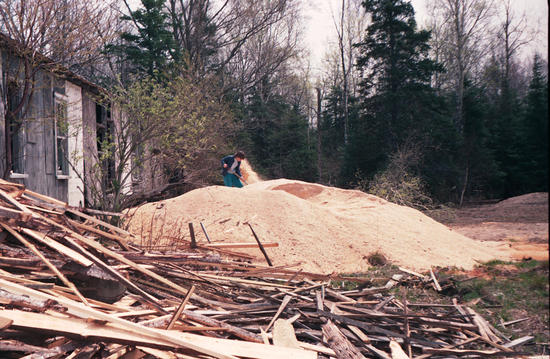 Cutting logs with this sawmill produced a lot of sawdust. With the 1/4" kerf of
the circular saw blade, if cutting 1" thick boards, 20% of the log would become
sawdust.
Cutting logs with this sawmill produced a lot of sawdust. With the 1/4" kerf of
the circular saw blade, if cutting 1" thick boards, 20% of the log would become
sawdust.
The sawmill had a chain to pull the sawdust out from under the blade and out of the building. Beyond that though, when running it for a few days, the sawdust had to be spread out with a shovel to make room for more.
Once in a while, when the pile was big enough, a farmer would come and get it for his barn. This was always a relief to me, because it meant no shoveling for a whole day, and not shoveling the sawdust as far the next day.
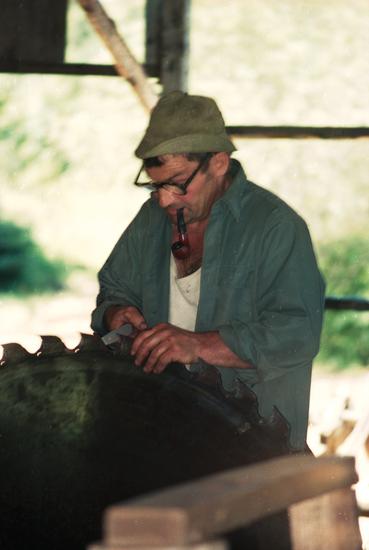 The saw blade had these replaceable teeth. Before replaceable
teeth, the teeth as well as the gap between them always had to be filed back
when sharpening. Over time, the saw blade would get smaller.
There was one such older saw blade kicking around, but we
never used it, and it wasn't as big either.
The saw blade had these replaceable teeth. Before replaceable
teeth, the teeth as well as the gap between them always had to be filed back
when sharpening. Over time, the saw blade would get smaller.
There was one such older saw blade kicking around, but we
never used it, and it wasn't as big either.
Every few hours of operation, the saw blade had to be stopped, and my dad filed the teeth. This needed to be done more often if the logs were dirty. When milling towards dusk, you could see the sparks when the blade hit some of the dirt. This is a reason why most sawmills peel the bark off logs before they mill them. Some of the fancier bandsaw sawmills have a small grinder to clear the dirt and bark where the blade enters the log.
Once or twice, early on, we ended up distorting the blade from overheating. To get it flat again, it needs to be hammered in a special way to equalize the stresses. People who knew how to hammer such a blade were a dying breed, even in the early 1980s. Once my dad got the hang of running the sawmill, I don't remember the blade ever needing hammering again.
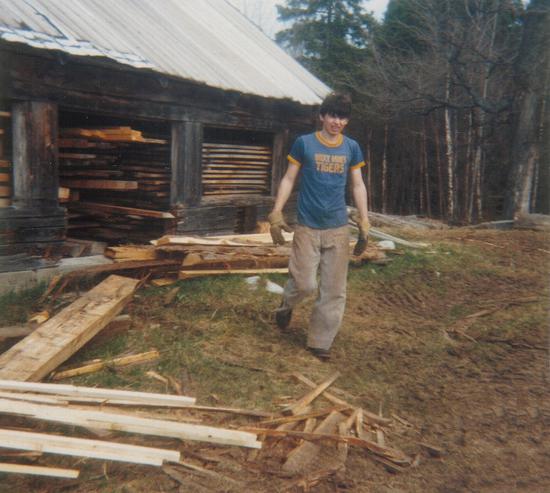 Here's me, in front of a small pile of thicker slabs I put aside.
Anything that was thick enough to cut a leg or back rail for a
lawn chair out of, I'd save.
I'd later mill rectangular pieces out of them on the bandsaw in my dad's shop.
Here's me, in front of a small pile of thicker slabs I put aside.
Anything that was thick enough to cut a leg or back rail for a
lawn chair out of, I'd save.
I'd later mill rectangular pieces out of them on the bandsaw in my dad's shop.
Behind me, one of several buildings we stacked lumber in for air drying.
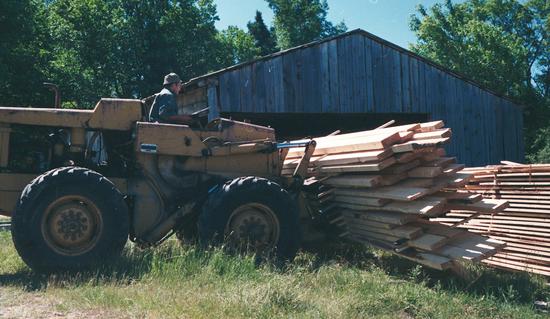 During the heavy snow of the 1996-1997 winter (the year before the rest of Ontario
got hit with the ice storm), most of the
sawmill building collapsed. My dad knew that it might buckle under the snow, but
he didn't really need the sawmill anymore, and didn't want to risk getting up on
it to shovel it when it was so heavily loaded already.
The sawmill was exposed to the elements for a few years before my dad let somebody
dismantle the machinery for a few hundred dollars.
The tractor and the loader have since been hauled away by a guy named Andy who keeps
both of them in running order. For a few years, Andy used the payloader to clear
his driveway until he built his homemade truck.
During the heavy snow of the 1996-1997 winter (the year before the rest of Ontario
got hit with the ice storm), most of the
sawmill building collapsed. My dad knew that it might buckle under the snow, but
he didn't really need the sawmill anymore, and didn't want to risk getting up on
it to shovel it when it was so heavily loaded already.
The sawmill was exposed to the elements for a few years before my dad let somebody
dismantle the machinery for a few hundred dollars.
The tractor and the loader have since been hauled away by a guy named Andy who keeps
both of them in running order. For a few years, Andy used the payloader to clear
his driveway until he built his homemade truck.
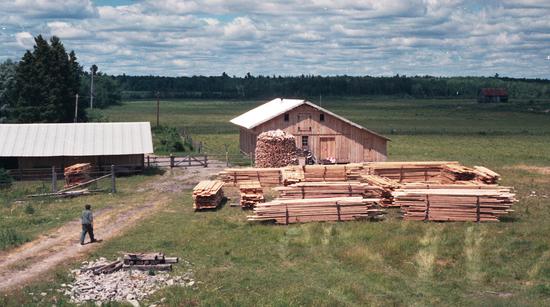 The whole sawmill was quite obsolete compared to some of the band saw mills that
are available today, although a bandsaw mill is apparently less forgiving to
unskilled operation.
The whole sawmill was quite obsolete compared to some of the band saw mills that
are available today, although a bandsaw mill is apparently less forgiving to
unskilled operation.
Still, the sawmill was very useful. You just can't walk into home depot and buy 3" thick oak planks, and even if they had it, it would cost an arm and a leg. Getting logs was also difficult though, and most of the logs my dad milled were from his own property, cut down by my dad.
The sawmill also came in very handy making beams for building cottages and the workshop.
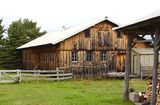 What became of the
What became of the